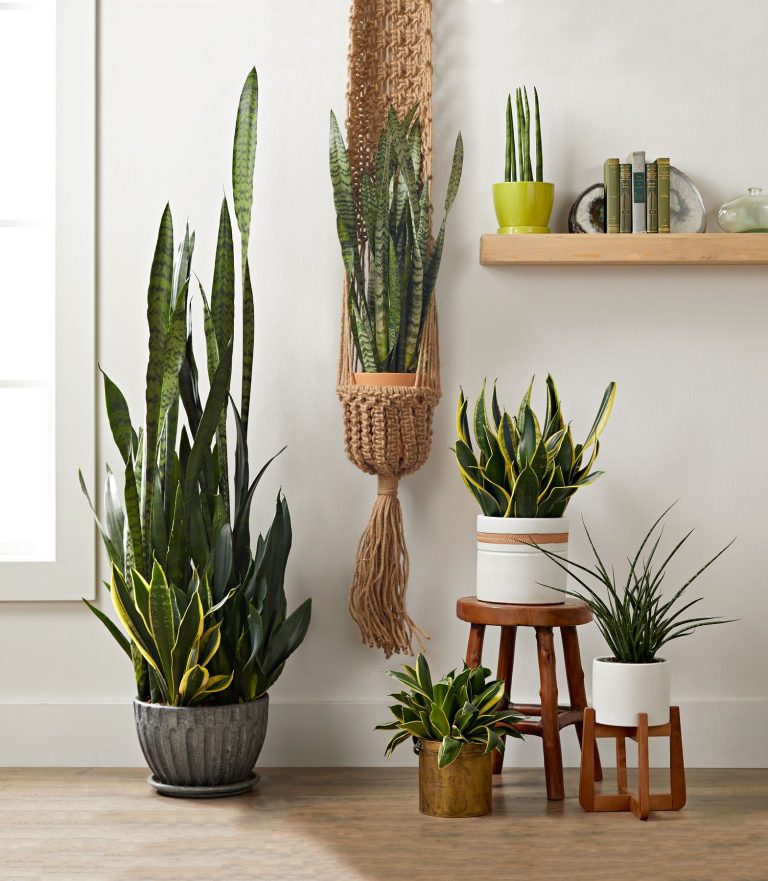One of the hardiest houseplants, Sansevieria can tolerate most indoor environments. With its stately, upright leaves, Sansevieria (also known as Mother-in-Law) adds architectural form to a room and complements any style of décor.
Sansevieria has no stems, just sturdy, thick, upright leaves, making it the perfect floor plant for small spaces. Some dwarf varieties form a rosette of small leaves. The most common leaves are a shade of green with silver-gray horizontal stripes. Some variegated varieties have cream or gold borders.
Given the right conditions, Sansevieria will flower. Though not showy, the flowers come in large clusters and are usually greenish-white in color. The small, tubular blossoms give off a sweet, floral scent that fills the room, but Sansevieria only bloom once every few years, on no particular schedule.
Sansevieria is poisonous to dogs and cats, so keep it away from household pets, and it is also poisonous to small children.
Sansevieria Overview
Genus Name: Sansevieria Scientific Name: Sansevieria Plant Type: Houseplant Height: 1-3 feet Width: 6-36 inches Leaf Color: Gray/silver Characteristics: Easy to care for Propagation Methods: Division, leaf cuttings, seeds
How and when to plant Sansevieria
Sansevierias are hardy plants, perfect for the home or office. This top-heavy plant requires a heavy container with a drainage tray. Fill the container with good, well-draining potting soil, place the plant in the container, tamp down the soil around the plant and water lightly. The best time to plant a Sansevieria is in the spring.
Sansevieria are cold hardy in USDA plant hardiness zones 10 through 12. In other regions where they are grown as houseplants, containers of sansevieria can be placed outside during the summer and brought back indoors before the weather gets too cold.
Although it will survive and grow in low light, it will tolerate all light levels and will grow faster in bright light.
Sansevieria Care Tips
Light
Ideally, sansevieria like a bright, but not direct, spot, although a dark corner will do just fine. Low light can cause some sansevieria varieties to lose color and taller varieties to develop long, droopy stems, but this isn't usually a problem.
Soil and Water
Water your Sansevieria at room temperature once the soil has dried. Wait a few minutes and discard any water that runs off into the tray under the container. This plant is very drought tolerant, but overwatering is its biggest weakness. Sansevieria needs a potting soil that drains well and doesn't retain too much water.
fertilizer
Sansevierias don't need much fertilizer — just a few fertilizers a year with a houseplant fertilizer will suffice.
Planting and replanting
Once you've planted your Sansevieria in well-drained potting soil, you won't need to repot it for several years. The plant is slow growing and doesn't mind being crowded as long as the roots aren't congested. If you keep it in a bright light location, it may need to be repotted in 3-5 years. If you keep it in a low light location, it may not need to be repotted for 10 years.
Pests and Problems
Sansevieria is a relatively pest-free plant, but it can be infested with mealybugs, aphids, spider mites, etc. If an infestation occurs, isolate the affected plant from other plants and spray it with insecticidal soap to prevent the spread of pests.
A bigger problem for Sansevieria is root rot. This plant cannot tolerate overwatering. Prevent root rot by watering only when you feel the soil is dry and by not leaving the plant in water. If root rot occurs, repot the plant using fresh potting soil and remove as much of the old soil as possible.
How to grow Sansevieria
Sansevieria are easily propagated by leaf cuttings. Simply cut a 3- to 4-inch piece of a leaf and insert it into moist potting soil. Keep the soil evenly moist but not waterlogged. In a few weeks to a month, a small seedling will begin to grow from the base of the cutting. This seedling can be separated into individual plants or left as a clump.
Most Sansevieria cultivars with variegated leaves are actually chimeras, mutations of a plant that cause variegated leaves. Chimeras may not reliably maintain their variegation or remain “true to type” when propagated by leaf cuttings, so division is usually recommended.
Types of Sansevieria
Bird's nest pepper
Dean Scheppner
Sansevieria trifasciata “Honey” grows to just over 6 inches tall and forms clusters of cup-shaped leaves that resemble a bird's nest.
Cylinder Sansevieria
Blaine Moats
Sansevieria cylindrica grows rounded, stiff leaves that can reach several feet in length. The leaves arch outward from a central crown.
Sansevieria “Laurentii”
Scott Little
Sansevieria trifasciata 'Laurenti' is a popular variety with creamy yellow leaf edges. Leaf cuttings will not produce seedlings and will revert to green, so you should divide the plant to create a new one just like the mother plant.
Variegated Sansevieria
Jason Donnelly
Sansevieria trifasciata is grown for its striking, upright shape with leaves that are 2 to 4 inches wide and several feet long, making it one of the best plants for low light locations.
FAQ
How long does Sansevieria live?
Most Sansevieria plants live up to 10 years, but some have been known to live as long as 25 years if properly cared for.
Is Sansevieria a cactus?
No, but it is related to some succulents such as aloe and agave.
What is another name for Sansevieria?
Besides mother-in-law's tongue, Sansevieria is also known as viper's bowstring, devil's tongue, snake's tongue and jinn's tongue.

